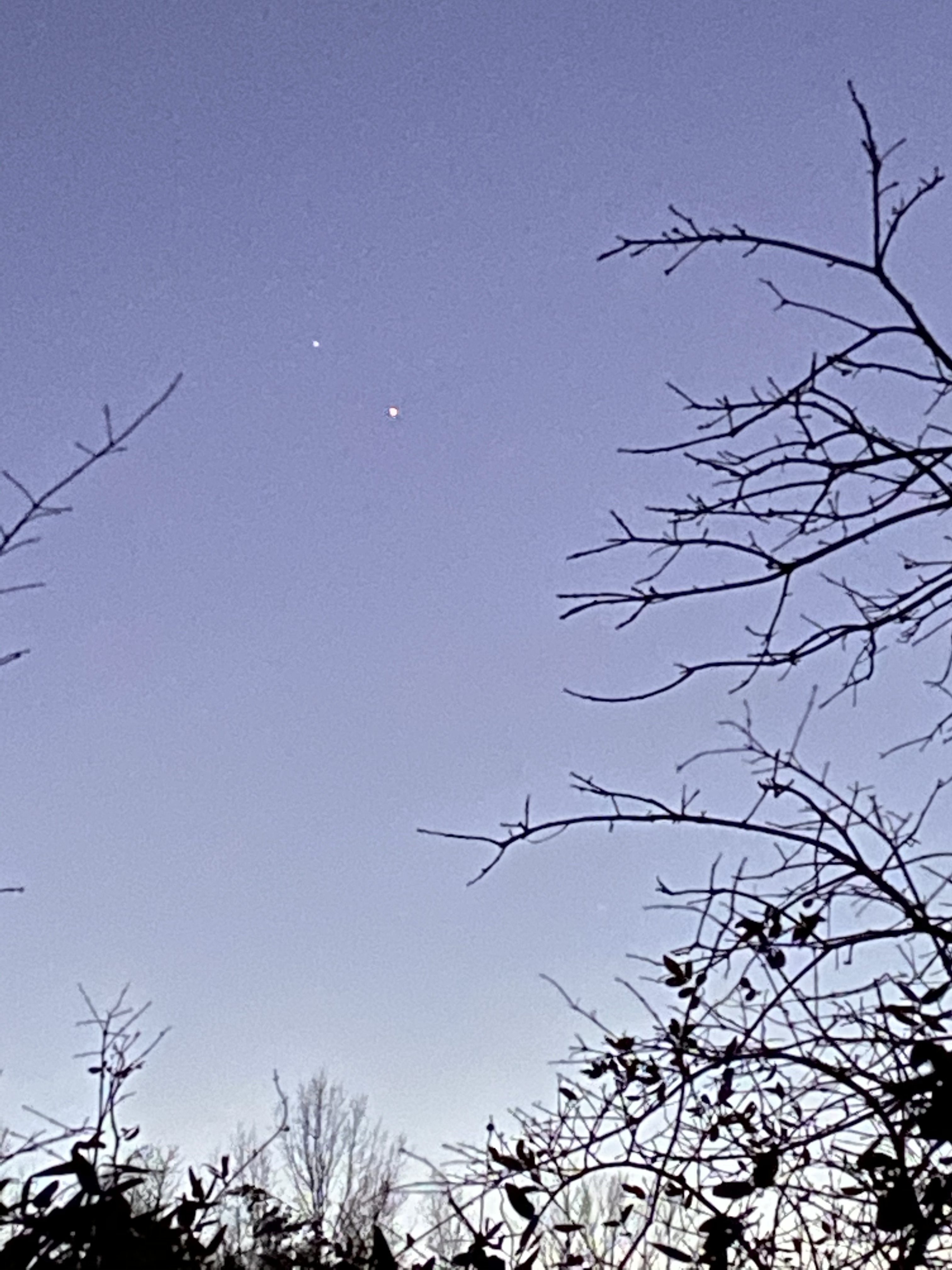Saturn (left) and Jupiter (7 Dec 2020) – Photo: L. Weikel
Eyes On the Sky
As many of you may know, eight hours after the precise moment of the Winter Solstice this year, on December 21st, 2020, we’ll have the opportunity to witness a pretty cool astronomical (and astrological) phenomenon: the conjunction of Jupiter and Saturn. But since these planets move so slowly, we won’t need to train our eyes on the sky at the precise moment of 1:20 p.m. ET. In fact, we won’t be able to see them then anyway. But we will be able to see them (weather permitting) just after dusk. And they should be quite a cool sighting.
Technically these two massive planets meet up with each other in a phenomenon known as a Grand Conjunction or a Great Conjunction (lining up in space from our perspective on Earth) every twenty years or so. But this year what we observe will be especially dramatic because the planets will be separated by only 0.1 degree. The last time these two met each other in the sky this closely was in 1623, but that took place so close to the sun that our ancestors may not have noticed. Indeed, it’s thought that the last time these two planets achieved this close of a conjunction that we could see from Earth was in 1226. Think of it! And the next time they’ll be almost as close will be in 2080 – a mere blip on the cosmic calendar to Jupiter and Saturn. But for us?
What About the Moon?
Luckily for us, the grand conjunction on December 21, 2020 will be taking place at a primo location in the sky for all of us to be able to witness the phenomenon. We’ll actually be able to see what appears to be a single, much brighter ‘star’ in the southwestern sky (if we’re in the Northern Hemisphere), which is actually just the two snuggling up very close to each other. There is conjecture that such a very close or tight conjunction of these two planets may have been the Christmas Star of Bethlehem.
Making this event extra special is the fact that it will be occurring at a time and place in the sky where the planets’ light won’t be drowned out by either the sun or the moon. Beyond the degree of closeness the planets achieve to each other, the presence (or absence) of the luminaries in the sky also determine how dramatic a conjunction appears to us – or if we can see it at all.
Yet another gift of 2020 (this time ‘for reals’ – an actual gift!), only a few days before Jupiter and Saturn technically conjunct, a waxing fingernail crescent of the moon will appear just below the two planets. We’ll be able to observe the three of them conversing in the southwestern sky just after sunset on the evenings of December 16th and 17th.

Perspective
While Karl and I were walking this evening, I managed to get a decent photo of Saturn and Jupiter, which I included at the top of this post. (It’s actually much more obvious and clear when observing with our naked eyes.) I’ll try to provide a few more shots of them over the course of the next two weeks as Jupiter really starts picking up speed, documenting their positions in the sky as they approach this grand conjunction.
Just to make things interesting, I’m including a photo (above) that I included with a post I wrote back in July, when I first started noticing and paying attention to their flirtations with each other. As you may recall, astrologically, we’ve been reaping the effects of Saturn, Jupiter, and Pluto all hanging out together in Capricorn since January of 2020 (heralding the arrival of Covid-19, among other things).
Tonight I’m focusing upon the astronomical aspect of the conjunction between Saturn and Jupiter. I’ll save a discussion of the astrological implications for another evening.
In the meantime, I can’t recommend highly enough the invigorating exhilaration you’ll feel by bundling up and taking a just-past-sunset stroll over the next several evenings. Watching the planets approach each other and realizing that it will be another 60 years before anyone gets to witness what we are now is just…cool.
It’s the little things in life. Or maybe it’s the cosmic things. Either way, I love sharing them with Karl and with all of you.

Sunset – 7 Dec 2020 – Photo: L. Weikel
(T-354)
